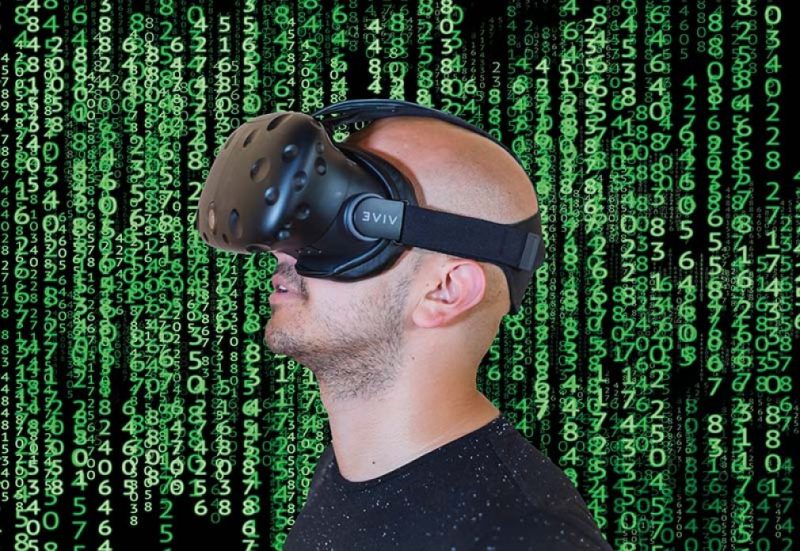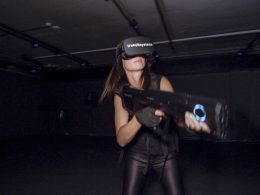Virtual and augmented reality are increasingly being used in the world of work. Occupational physicians examine possible health risks.
The coronavirus pandemic has forced employees around the world to work from home - with the familiar advantages and disadvantages. The major Swiss bank UBS is pursuing an interesting way to give its securities traders back the feeling of their usual workplace. A task force is examining the use of Google Hololens devices, which are intended to bring a little stock market feeling into the living room.
Negative test results
In a Interview Beatriz Martin, head of UBS UK, explained the strategy in an interview with the Financial Times: "If people really can't come into the office, can we create a virtual presence?" A previously tested option of equipping traders with screens on which their office colleagues could be seen in live feeds was shelved - the hoped-for sense of community had not materialised.
US bank Citigroup trialled the virtual office four years ago. A specially designed "Holographic Workstation" combined 3D holograms with real-time financial data. The system was designed for major customers, who had graphics and tables projected into the office by their trader during the meeting to visualise the data. However, the project failed due to the inadequacies of the technology at the time, such as the clunky headsets and limited computing power.
We have already seen another similar project from the French-speaking Swiss online bank Swissquote. presented.
The further development
Even if such concepts are still in their infancy and require further development to be successful, they give an impression of how the office of the future could look and function. So far, augmented and virtual reality have mainly been used in industry - especially in the areas of construction, planning, design and training. In medicine and in the maintenance and repair of devices, step-by-step instructions and other information displayed in parallel are of great benefit. A fully virtualised office would make physical offices completely superfluous.
Access to databases would not only be possible via the computer. "With our virtual system, we make the data tangible and enable it to be arranged in space," says computer scientist Thies Pfeiffer, who developed a corresponding method in the CITEC Cluster of Excellence at Bielefeld University in cooperation with software manufacturer Ceyoniq Technology.
Interaction takes place via nodding, eye movements, gestures or voice commands. Despite the high initial costs, the investment is worthwhile in some areas: Virtual training makes sense when real-life training is expensive, time-consuming or even dangerous. If one of these points applies, companies can usually develop a more flexible solution with XR.
Trip hazard health risks
The wider use of the technologies is now also attracting the attention of occupational physicians and safety experts. In Austria, the potential health risks of augmented reality are currently being examined as part of a joint project between the PRO-GE manufacturing union, the Austrian Institute of Technology (AIT), the Magna industrial group, AUVA and the Chamber of Labour.
"The first phase deals with the psychological effects at work," explains Sebastian Egger-Lampl, communications engineer and sociologist in the AIT research team. "The second phase focusses on safety aspects, for example if an object is lying on the floor in front of you while you are wearing your glasses. The third phase examines how long the neck muscles can be strained by wearing them." The fatigue of the muscles and the work experience are measured.
Limit duration
Tripping over a cable or bumping into a table while moving through other worlds with glasses in front of your eyes are the least of the dangers, albeit not the least likely. Nevertheless, the Berlin office fit-out company System 180 has already designed an ideal space for virtual work, which also characterises the radius of action with different floor coverings.
Perceptual irritations are more common with VR applications than with augmented reality, where the real environment remains visible and only additional information is displayed in the glasses. The VR disease "motion sickness" occurs because the movement perceived by the body in reality differs from the acceleration depicted virtually. Almost two thirds of users complain of dizziness and nausea, similar symptoms to those experienced with seasickness. In this case, the session should be interrupted immediately and the glasses removed.
Intensive research is being conducted into the strain that AR and VR glasses place on the eyes. One problem is that the eyes have to focus on a very close object for long periods of time. Ophthalmologists also speak of the so-called vergence-accommodation conflict, which occurs when the eye adopts a position similar to the squint effect in order to achieve the stereoscopic 3D effect. Frequent use of VR could lead to the development of short-sightedness - investigations into this are still ongoing.
Some manufacturers generally recommend limiting the duration of use to 30 to 50 minutes and then taking a break for at least 15 minutes. The damaging effect on children's eyes has already been diagnosed, which is why children under the age of 12 should not use VR applications.
Legal concerns
The work instructions displayed in AR systems are helpful in making processes more efficient and safer by automatically recognising errors and providing solutions. At the same time, the information can be distracting or restrict the field of vision, which increases the risk of accidents.
AR and VR systems also enable the complete documentation and monitoring of all activities and work steps. This is already problematic from a legal perspective, but could also lead to psychological stress for employees - the more commands are given via the glasses, the stronger the feeling of surveillance.
Technological advances in recent years have significantly improved the hardware and software. The data glasses no longer heat up as much as they used to and are much lighter, with larger viewing windows. The 5G network should also significantly speed up the recognition and processing of data points. The computing power required for higher resolution moving images is enormous - side effects such as the aforementioned dizziness could be minimised in future as the time delay in the display is eliminated. We are also constantly working on improving gesture and voice control in problematic situations, e.g. in noisy working environments or when no hand is free.
Head-mounted displays definitely have one advantage: instead of the rigid activity at the desk with keyboard, mouse and screen, virtual or augmented reality could bring movement into the working world.
Source: report









